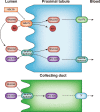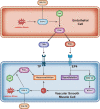Insights into SGLT2 inhibitor treatment of diabetic cardiomyopathy: focus on the mechanisms
- PMID: 37055837
- PMCID: PMC10103501
- DOI: 10.1186/s12933-023-01816-5
Insights into SGLT2 inhibitor treatment of diabetic cardiomyopathy: focus on the mechanisms
Abstract
Among the complications of diabetes, cardiovascular events and cardiac insufficiency are considered two of the most important causes of death. Experimental and clinical evidence supports the effectiveness of SGLT2i for improving cardiac dysfunction. SGLT2i treatment benefits metabolism, microcirculation, mitochondrial function, fibrosis, oxidative stress, endoplasmic reticulum stress, programmed cell death, autophagy, and the intestinal flora, which are involved in diabetic cardiomyopathy. This review summarizes the current knowledge of the mechanisms of SGLT2i for the treatment of diabetic cardiomyopathy.
Keywords: Diabetic cardiomyopathy; Mechanisms; Sodium-glucose cotransporter 2 inhibitor.
© 2023. The Author(s).
Conflict of interest statement
The authors declare that they have no competing interests.
Figures






Similar articles
-
Crosstalk between Sodium-Glucose Cotransporter Inhibitors and Sodium-Hydrogen Exchanger 1 and 3 in Cardiometabolic Diseases.Int J Mol Sci. 2021 Nov 24;22(23):12677. doi: 10.3390/ijms222312677. Int J Mol Sci. 2021. PMID: 34884494 Free PMC article. Review.
-
Effects of empagliflozin in different phases of diabetes mellitus-related cardiomyopathy: a prospective observational study.BMC Cardiovasc Disord. 2021 Apr 29;21(1):217. doi: 10.1186/s12872-021-02024-3. BMC Cardiovasc Disord. 2021. PMID: 33926386 Free PMC article.
-
Autophagy-dependent and -independent modulation of oxidative and organellar stress in the diabetic heart by glucose-lowering drugs.Cardiovasc Diabetol. 2020 May 13;19(1):62. doi: 10.1186/s12933-020-01041-4. Cardiovasc Diabetol. 2020. PMID: 32404204 Free PMC article. Review.
-
Sodium/glucose cotransporter 2 (SGLT2) inhibitors improve cardiac function by reducing JunD expression in human diabetic hearts.Metabolism. 2022 Feb;127:154936. doi: 10.1016/j.metabol.2021.154936. Epub 2021 Nov 18. Metabolism. 2022. PMID: 34801581 Clinical Trial.
-
Heart Failure and Diabetes: Perspective of a Dangerous Association.Curr Hypertens Rev. 2021;17(2):85-93. doi: 10.2174/1573402117666210406111927. Curr Hypertens Rev. 2021. PMID: 33823781 Review.
Cited by
-
SGLT2 inhibition, blood lipids, and cardiovascular disease: A Mendelian randomization study.ESC Heart Fail. 2024 Dec;11(6):3960-3971. doi: 10.1002/ehf2.14987. Epub 2024 Jul 25. ESC Heart Fail. 2024. PMID: 39054757 Free PMC article.
-
mTORC1 and SGLT2 Inhibitors-A Therapeutic Perspective for Diabetic Cardiomyopathy.Int J Mol Sci. 2023 Oct 11;24(20):15078. doi: 10.3390/ijms242015078. Int J Mol Sci. 2023. PMID: 37894760 Free PMC article. Review.
-
Impact of SGLT2 Inhibitors on Lipoproteins in Type 2 Diabetes.Curr Diab Rep. 2025 Jan 7;25(1):16. doi: 10.1007/s11892-024-01572-0. Curr Diab Rep. 2025. PMID: 39762665 Review.
-
Improving heart failure outcomes with sodium-glucose cotransporter 2 inhibitors in different patient groups.Diabetes Obes Metab. 2023 Jul;25 Suppl 3(Suppl 3):26-32. doi: 10.1111/dom.15171. Epub 2023 Jun 19. Diabetes Obes Metab. 2023. PMID: 37334518 Free PMC article. Review.
-
Progress in the treatment of diabetic cardiomyopathy, a systematic review.Pharmacol Res Perspect. 2024 Apr;12(2):e1177. doi: 10.1002/prp2.1177. Pharmacol Res Perspect. 2024. PMID: 38407563 Free PMC article.
References
-
- Ahmed AM. History of diabetes mellitus. Saudi Med J. 2002;23:373–378. - PubMed
Publication types
MeSH terms
Substances
LinkOut - more resources
Full Text Sources
Medical

